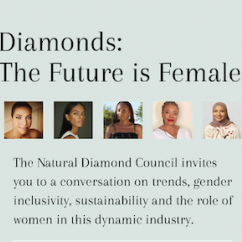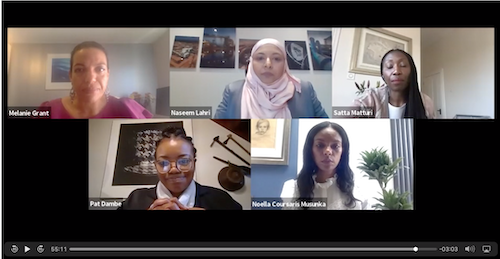Articles and News
Natural Diamond Council: Why The Future Of Diamond Mining Is Female | July 22, 2020 (3 comments)

London, UK—On July 17, the Natural Diamond Council (formerly the Diamond Producers Association) hosted a webinar focusing on the changing roles of women in the diamond supply chain. Melanie Grant, luxury editor from The Economist’s 1843 magazine moderated the live debate, “Diamonds: The Future is Female,” which was held on Zoom and livestreamed on Facebook.
Her four guests included model and philanthropist Noëlla Coursaris Musunka, founder and CEO of the charity Malaika; Naseem Lahri, managing director of Lucara Diamond Botswana; jewelry designer Satta Matturi, who also works as an independent rough diamond valuator; and Pat Dambe, vice president of corporate affairs and government relations for De Beers Group.
The conversation addressed everything from the impact of diamond mining around the world to how an increasingly strong representation of women in the workforce is helping to build and positively impact entire communities.
Melanie Grant: Historically, a pivotal moment for women came in early 2000s when the South African Mining Charter introduced a quota of 10% diversity. It was later updated to include 25% black women at board level and other senior levels. The world is changing and power is evolving, especially in recent times. We think it’s good for business that we have more diversity, but challenges remain.
Noella Coursaris Musunka: I was born in the Democratic Republic of Congo but sent to live with relatives in Europe, where I earned a business degree and formed my nonprofit. What that taught me is the value of education. Education is opportunity but so many girls are denied it in Africa. Education is the power to change. Education is the tool for that will get them there.
I’ve observed how an entire village was transformed because of the ripple effect of education. It’s an ecosystem created by four pillars: a school of 350 students, a community center impacting more than 5,000 people a year, and we built 20 wells and sustainable agriculture and infrastructure in a village with no water and no electricity.
It’s not only about creating a school, it’s about high quality education and adapting curriculum for 21st century. For instance, in this school, students with 3D printers have done more than 900 mask shields for COVID-19. We teach them how to serve their country and continent.
MG: What can the diamond industry do toward gender inclusivity?
NCM: Africa is so rich in mineral wealth, not just diamonds. Mining therefore lies at heart of the economy of many of these countries. But it has to serve the population to create a middle class. That requires access to school, health care, and so forth. Allowing girls to reach full potential has lasting effect on whole country and whole continent.
MG: There are very few jewelry designers who are black and women at a high level.
Satta Matturi: Correct! There are very few black jewelry designers and only a handful of us in the fine jewelry space. There are so many networks and layers that to understand and penetrate throughout the value chain to get your name and brand out there. It’s very challenging for anyone starting out.
MG: Where are biggest challenges?
SM: If I can touch on a few barriers to entry, one, the business itself is capital intensive. You’re operating an entity that has long inventory cycles and I’m not even going to go into the retail side with memo and consignment. Just look at the raw materials! They’re expensive. I’m developing a collection now, and I got ready to do pricing and looked at gold and almost fell off my chair!
Then you have to network at every single level of the industry. You need role models and mentorship. There’s a lack of black female role models out there. As an industry we need to collectively get together, identify those success stories, and celebrate them.
MG: Some shoppers, especially Millennials, still associate diamonds with conflict. Pat, can you give us a basic view of De Beers’ blockchain technology?
Pat Dambe: A lot of Millennials assume a lot of diamonds are associated with conflict or environmental issues. It’s not true. In a lot of countries diamonds are driving significant [positive] change in the communities where they come from.
Diamonds have made a significant contribution to lives of everyone in Botswana. As result of the partnership of DeBeers and the Botswana government, everyone has free education from preschool to university and excellent medical care.
The easiest way to describe blockchain is all about what and how and who. With AI and high grade security and privacy you’re creating platform allowing you to trace the diamond from mine to finger. This way the consumer can ask the important questions and get an answer.
MG: How have issues of sustainability and progress impacted women?
PD: A lot of sustainable development goals focus on women and children. Where there are children, there are women and so a lot of SDG goals are maternal. We try to continue our focus on women as they look after the community.
MG: Nasseem, why do you think in mining future is female?
Naseem Lahri:The mining sector is a very dynamic, continuously changing environment. Every day is different. It needs decisive people who are informed but quickly able to make decisions, especially about the safety of our people.
Women have the most amazing qualities and one of them is being adaptable. We are tenacious. [Don’t] tell a woman she can’t do something. We multitask inherently; we don’t even know we’re doing it. We’re passionate, empathetic, and decisive. We all share these qualities. So I actually think mining was made for women!
I will come back to my roots as an accountant and talk numbers. When you have diversity and inclusivity and if a woman is leading an organization, you have a 34% greater return. It’s been proven that if you have women in managerial roles the numbers increase and the bottom line benefits.
Participants in the Natural Diamond Council "The Future Is Female" webinar.
MG: Let’s discuss something very controversial: quotas. Many people think we should have quotas and many think we shouldn’t.
NL: I’m one of those that doesn’t believe in quotas. In our organization, promotions for women happen organically. If you’re the right person for the job you get the job. Then the company is not forced to meet a number or put someone in a box or position. When it happens organically it’s much more sustainable for the organization.
NCM: It starts in school, where education should not stereotype by gender in training.
PD: But we’re speaking to the converted here. As much as we sit here, we know the stories we’ve been through. We’ve been through the man story. Not that it was deliberate, but there’s a total misunderstanding of the attributes of women. We’ve all sat in that meeting where you’re the minority and you’re thinking, ‘is it me or is it them?’ You think one way but it’s always been a [male] vertical thought process [whereas] women are agile and go to new frontiers.
Quota is something that should not happen but it does take a partnership. It’s a different conversation when women are sitting around the table. [Men] will say ‘you’re right because we can’t fulfill those gaps.’
MG: Networks for the trade are still very male. I know when I started off and was going around to see people, if I went with male colleague they’d talk to him first like I wasn’t there.
PD: With women, we talk about skills, but for men we talk about networks. A lot of men got where they are without skills. They had the capability, the network, and the mentoring, and they learn and develop in the position. But women are told to have the skills first; to meet the criteria. We need a different conversation around that.
There needs to be a network, a force, a movement. That’s another thing. How do we develop that and mentor that when women have the capability and potential just like men?
SM: We also need to look at history, where it’s always been patriarchal, men designing, making, and marketing a beautiful object for women. Now there’s a space for women designing jewelry for women. Lots of women are sitting and making jewelry. Women are leading massive design teams for big jewelry houses. Louis Vuitton has a female leading its team. Women are making decisions with huge marketing budgets.
NL: Three years ago, I was lone female in our board room. Now 75% of us are female. We have to reinforce with young girls that they can do anything they want. We have to come out of that sphere where admin jobs are for women and technical jobs are for men.








